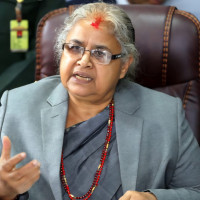- Wednesday, 7 January 2026
Complete Development Projects On Schedule
The Ministry of Finance (MoF) issues guidelines to line ministries and other relevant agencies for the proper and timely utilisation of the development budget every year. Even parliamentary committees and anti-corruption bodies like the Office of the Auditor General (OAG) are found repeatedly alerting development agencies against their last-minute rush to spend the capital budget. Despite all these, what is worrying is that the practice of expending a large proportion of the development budget during Asar (June-July), the final month of the fiscal year, has continued. Like in the previous years, Nepal witnessed a huge amount of capital budget being spent in the month of Asar of the last fiscal year as well. The country’s financial
system remains closed on Asar 25 (July 9 this year).
Poor performance
With its poor performance in utilising budget, the federal government was able to spend just about 63 per cent of its total capital budget (352.35 billion) allocated for various development projects in the last fiscal year. But, as much as Rs. 18 billion was spent in the final week of that fiscal year alone. This paints a gloomy picture of the capital budget spending. The trend of spending the capital budget has not remained so effective over the years. In 2023-24, only around 63.47 per cent of the total capital budget was spent, while it was 61.44 per cent and 57.23 per cent in 2022-23 and 2021-22, respectively. This shows the continuation of a nearly similar trend of capital budget spending in the country.
Spending budget at the eleventh hour is not a positive indication. Mostly, this tendency results in poor quality work and increased risk of fiscal irregularities. The practice among development stakeholders, especially development authorities and contractors, to defy the fiscal discipline is one of the obstacles to the timely execution of the capital budget in the country. Most Nepalis are quite familiar with the term ‘Asare Bikas’. They know that development projects are executed hurriedly in the final month of the fiscal year just for the sake of execution. This means that they intend to misuse the resources for their private gains.
Even in the rainy month of Asar, workers were seen digging roads and pavements even within the Kathmandu Valley, causing much inconvenience to commuters and vehicles alike. Development activities such as maintenance and construction of roads and laying down drinking water pipes and electricity wires should have been carried out days before the start of the rainy season. Oftentimes, there is a lack of proper coordination among different public agencies like the Department of Roads, Nepal Electricity Authority (NEA), Kathmandu Upatyaka Khanepani Limited (KUKL), among others. This not only causes a nuisance to the general public but also leads to a waste of resources and time.
When authorities accelerate development project activities just before deadlines, they are less likely to be guided by their good intentions. Such a rush to finish the development budget may lead to the creation of poor-quality infrastructure and misuse of scarce resources. Delayed development projects contribute to slowing down capital expenditure, disrupting proper cash flow. Ultimately, this negatively affects the entire financial sector. Each year, the federal government reiterates its pledges to expedite capital spending. But, no tangible progress seems to have been made towards this end.
The country’s experiences seem to have shown that development projects such as constructions and repairs of roads, irrigation canals and drainage systems are delayed deliberately just to misuse resources. It is said that there is collusion among development authorities, contractors and elected people’s representatives for the misappropriation of the budget. Anti-graft agencies like the Commission for Investigation of the Abuse of Authority (CIAA) and the Office of the Auditor General (OAG) can be instrumental in preventing and fighting irregularities seen even in development projects.
The CIAA can investigate apparent corruption, register charge sheets against individuals or agencies involved. It can also work together with other public bodies to ensure accountability and transparency. Besides, it can create public awareness about the impact of corruption on society as a whole. Because the OAG’s audit reports point to irregularities and possible corruption, they call for further investigation and necessary corrective action. Such steps can help contain corruption to a great extent. However, the misuse of development funds is still rampant nationwide.
Negligence
Development organisations must start carrying out tasks related to project implementation on time to avoid the last-minute haste and complete projects on schedule. The MoF also try to release the development budget on time to enable development agencies to execute projects before the monsoon. But, with a fall in revenue collection and foreign loans and grants, it is very challenging for the government to manage development resources on time. However, several road and highway projects are still incomplete due to negligence on the part of the responsible authorities. So, the authorities concerned and contractors must be held accountable for such problems.
Meanwhile, the MoF has lately issued 95-point guidelines to all ministries, departments and bodies for the implementation of the budget for the current fiscal year. It has asked the relevant bodies to make necessary arrangements for the selection of a project leader based on internal competition to effectively execute the project within the specified time. Moreover, it has sought the standards to ensure that the project chief is not transferred throughout the project period. Because of frequent transfers of the project chiefs, which have been a major problem leading to the incompletion of projects, the MoF has included this provision in the guidelines. Project employees’ integrity and dedication are equally essential. Regular supervision and monitoring of projects are also key to their success.
(The author is a former deputy executive editor of this daily.)















